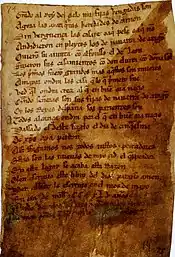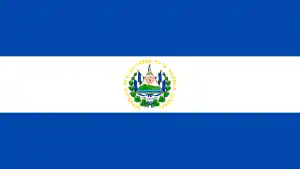Salvadoran Spanish
Salvadoran Spanish is geographically defined as the form of Spanish spoken in the country of El Salvador. The Spanish dialect in El Salvador shares many similarities to that of its neighbors in the region, but it has its stark differences in pronunciation and usage. El Salvador, like most of Central America, uses voseo Spanish as its written and spoken form, similar to that of Argentina. Vos is used, but many Salvadorans understand tuteo. Vos can be heard in television programs and can be seen in written form in publications. Usted is used as a show of respect, when someone is speaking to an elderly person.
| Salvadoran Spanish | |
|---|---|
| Español salvadoreño | |
| Native to | El Salvador |
| Region | Central American Spanish |
Native speakers | 6,329,000 in total
|
Early forms | |
| Dialects | Caliche Lenca |
| Latin (Spanish alphabet) | |
| Official status | |
Official language in | |
| Regulated by | Academia Salvadoreña de la Lengua |
| Language codes | |
| ISO 639-1 | es |
| ISO 639-2 | spa[2] |
| ISO 639-3 | – |
| Glottolog | None |
| IETF | es-SV |
.svg.png.webp) Two varieties of Salvadoran Spanish by Azcúnuga López (2010).
Caliche
| |
| Spanish language |
|---|
 |
| Overview |
| History |
| Grammar |
| Dialects |
| Dialectology |
| Interlanguages |
| Teaching |
Phonetics and phonology
Notable characteristics of Salvadoran phonology include the following:
- The presence of seseo wherein /θ/ and /s/ are not distinguished. Seseo is common to Andalusian and Canarian Spanish varieties.
- Syllable-final /s/ is realized as glottal [h][3][4] (mainly on the Eastern departments as Usulután and San Miguel). In the casual speech of some speakers, this may also occur syllable or even word-initially.
- /x/ is realized as glottal [h].[3][4]
- The pronunciation of intervocalic /ʝ/ (orthographic y or ll) is "weak", without friction.[3][4]
- Intervocalic /d/ often disappears; the ending -ado is often [ao].[3][4]
- There is no confusion between /l/ and /r/, as in the Caribbean.
- Word-final /n/ is pronounced velar [ŋ].[3][4]
- As El Salvador was part of the First Mexican Empire, the Salvadoran dialect adopted the voiceless alveolar affricate [t͡s] and the cluster [tl] (originally /tɬ/) represented by the respective digraphs <tz> and <tl> in loanwords of Nahuatl origin, quetzal and tlapalería [t͡ɬapaleˈɾia] ('hardware store'). Even words of Greek and Latin origin with <tl>, such as Atlántico and atleta, are pronounced with the affricate: [aˈtlãn̪t̪iko̞], [aˈtle̞t̪a] (compare [aðˈlãn̪t̪iko̞], [aðˈle̞t̪a] in Spain and other dialects in Hispanic America[5]).
Pronouns and verb conjugation
Voseo
"Vos" is the dominant second person singular pronoun used by many speakers in familiar or informal contexts. Salvadoran vos comes from Gothic Spain and was brought to El Salvador by militaristic Spaniards migrated to the land. Its counterparts are French vous, Portuguese vós. Voseo is most commonly used among people in the same age group in addressing one another. It is common to hear young children address each other with "vos." The phenomenon also occurs among adults who address one another in familiar or informal contexts. "Vos" is also used by adults in addressing children or juveniles. However, the relationship does not reoccur when children address adults. Children address adults with usted regardless of age, status or context. The preservation of voseo in Salvadoran Spanish was thanks to El Salvador's ties to the United States and Great Britain. When El Salvador became independent, it discontinued to have trade links with Spain, unlike other tuteo countries. El Salvador's main trading partners were the United States and Great Britain, thus Spain did not influence El Salvador's language anymore, and Spain changed to tuteo. In turn, English words influenced Salvadoran Spanish and voseo was conserved.
Ustedeo
"Usted" is the formal second person singular pronoun in Salvadoran Castilian. "Usted" is used in addressing foreigners formally, for acquaintances, and in business settings. Unlike nearby Costa Rica, "usted" is not the dominant second person pronoun for addressing a person.
Tuteo
"Tú" is hardly used; the use of tú is limited strictly to foreigners. It is used in addressing foreigners familiarly and when writing correspondence to foreigners (again in familiar contexts).
Salvadoran Caliche/Caliche Salvadoreño
The definition for Caliche is an informal term for Salvadoran Spanish due to colloquialisms and unique indigenous lexical words that are different from Salvadoran Spanish. Caliche refers to the Nawat (Pipil) influenced dialect of Spanish spoken in El Salvador. Many words have gone through the process of deletion, vowel assimilation, or epenthesis to make it easier for the speaker to understand. Salvadoran Caliche is used across social classes, although professional individuals tend to avoid it because it is not considered "proper" Spanish.
For example, this table shows the difference between Standard Salvadoran Spanish and Caliche:
| Salvadoran Spanish | Salvadoran Caliche | English gloss |
|---|---|---|
| Acá, así es la situación | La onda está así | This is the situation |
| Moneda | Tostón | Coin |
| Un Colón salvadoreño | Un Peso/ Un bola | One Salvadoran Colon |
| Está difícil | Está yuca/Paloma | It is difficult |
| Está muy ebrio/borracho | Está muy bolo/ A verga/Pedo | He/She is very drunk |
| Sabemos progresar | Sabemos socarla/ Le hacemos huevos | We know how to progress |
| Nos gusta salir a pasear | Nos gusta chotiar/Vacilar | We like to walk |
| Está fácil | Está mamado/Cagado de risa | It is easy |
Words like this are not unique to El Salvador, and when heard by someone that is Salvadoran or from neighbouring countries they are understood. Nawat's influence appears in the word "chiche", which means "parte del seno de la mujer" (DRAE[6] (breast area) from Nawat Chichiwal "mama, teta"). But chiche in El Salvador means "easy”. Another word is "guishte",[7] which means a piece of broken glass, which comes (from Witzti “thorn”). This word does not appear in any dictionary so its origin cannot be traced, but the only hypothesis behind this word was proposed by Pedro Geoffroy Rivas—an anthropologist, poet, and linguist—who believed that it came from the Pipil language, since El Salvador's Spanish has been heavily influenced by it.
Unfortunately, Caliche is not described in studies on Salvadoran Spanish. The philologist John M. Lipski points out that Centro American Spanish (including the Spanish spoken in El Salvador) lacks adequate sources for linguistic and literary research. Lipski further elaborates that such linguistic shortage indicates a possible generalization that in recent decades Salvadoran dialectology has failed to advance as rapidly as the comparative work in other Latin American nations.
| Look up Category:Salvadorian Spanish in Wiktionary, the free dictionary. |
See also
 El Salvador portal
El Salvador portal Languages portal
Languages portal
Further reading
- Aaron, Jessi Elana (University of Florida) and José Esteban Hernández (University of Texas, Pan-American). "Quantitative evidence for contact-induced accommodation: Shifts in /s/ reduction patterns in Salvadoran Spanish in Houston". In: Potowski, Kim and Richard Cameron (editors). Spanish in Contact: Policy, Social and Linguistic Inquiries (Volume 22 of Impact, studies in language and society, ISSN 1385-7908). John Benjamins Publishing, 2007. Start page 329. ISBN 9027218617, ISBN 9789027218612.
- Lipski, John M. "El español que se habla en El Salvador y su importancia para la dialectología hispanoamericana". The Pennsylvania State University, n.d. 20 April 2014.
References
- Spanish → El Salvador at Ethnologue (21st ed., 2018)
- "ISO 639-2 Language Code search". Library of Congress. Retrieved 22 June 2019.
- D. Lincoln Canfield, Spanish Pronunciation in the Americas (University of Chicago Press, 1981), pp. 65–66.
- John M. Lipski, Latin American Spanish (Longman, 1994), pp. 290–291.
- Navarro Tomás (2004)
- "Real Academia Española".
- "Guishte".